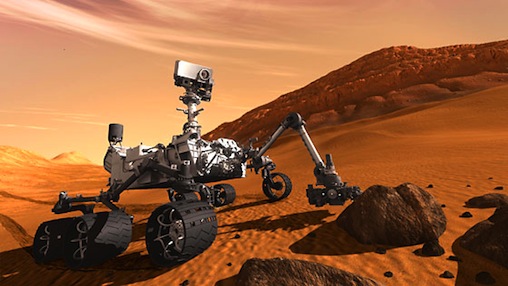While the Mars Curiosity rover is the most complex machine NASA has ever sent to another planet, the computer that runs it is no more powerful than the one in your smartphone.
The robotic rover, which landed in the Gale Crater on Mars early Monday morning, now is being put through a series of tests to make sure all of its systems are functioning properly after its more than 350-million-mile journey from Earth. It may be several weeks before the SUV-sized robotic rover is ready to begin its trek across the Martian surface.
Curiosity is on what scientists hope will be a two-year mission to find out if the planet has or ever has had what it takes to support life, even in a microbial form. The rover also will look for signs that humans could one day live on Mars.
While Curiosity is on a major scientific mission, the rover itself is something of an engineering marvel, too, according to the men and women who built it.

The Mars rover Curiosity has two computers, four chips and software designed to last throughout its two-year mission.
The rover not only has to be sturdy enough to survive a more than eight-month journey through outer space to reach Mars, once there, it has to be able to work in brutal temperature extremes for years.
"This is the most complex system that we've every sent to another planet," Devin Kipp, an operations lead on NASA's Curiosity team, told Computerworld. "The entry and landing system was the most complex system we've ever attempted. And now that it's on the ground, it's incredibly capable. The amount of state-of-the-art scientific instruments is really impressive."
Curiosity, which weighs nearly 2,000 pounds and carries 17 cameras and 10 scientific instruments, only has two computers and four processors.
Jonathan Grinblat, an avionics systems engineer with the Jet Propulsion Laboratory, said the rover used one Sun Microsystems Sparc processor to run the craft's thrusters and descent-stage motors as it moved through the Martian atmosphere. With the rover on the ground, that processor's job is done.
After the landing, a PowerPC processor, which was originally developed by the Apple-IBM-Motorola alliance, known as AIM, has taken over. This main processor, which has a redundant backup processor, runs all of the main software on the rover, handling "pretty much everything the rover will do," according to Grinblat.
The fourth chip, which also is a Sparc processor, is in Curiosity's motor controller box. Grinblat explained that the main processor sends it commands and this one handles the logistics of getting the motors to move.
All of the processors are single-core. Grinblat noted that Curiosity will be one of the last generations of NASA spacecraft that will have single-core chips.
"This project has been in development for more than 10 years," he said. "Multi-core, space-certified chips weren't available back then. Now, they are available, so they'll probably be used in projects eight to 10 years from now."
Grinblat added that any spacecraft being launched in the next several years still won't carry multi-core chips because of the long development time. "Because of that, we lag behind in the latest and greatest, especially since there's so much work to do to make them space ready," he said.
Curiosity only has two computers onboard: one main computer and one backup, according to Kipp. Both have been hardened to handle the rigors of temperature extremes and solar radiation.
Neither is a supercomputer. In fact, they're not even as powerful as today's laptops. Grinblat explained that the computer doesn't have to be highly powerful. It needs to be able to handle basic functions, but it's more important that it be able to survive and work in the harsh conditions in space and on Mars.
"It's not more powerful than my cell phone," said Grinblat. "They have to be tolerant to radiation so they run much slower and their feature sizes are much larger than modern-day processors. The smaller they are, the more susceptible they are to radiation. We 're constantly getting bombarded with particles. A processor with a much smaller feature size would mean more errors than it could handle."

Because of this, he added that an Intel Core i7 processor, for example, wouldn't survive a day on Mars because of the extremes in temperature.
Despite the fact that Curiosity doesn't have a huge amount of compute power, it's still a smart machine, able to scan its environment and make decisions.
Kipp noted that the rover has an Auto Nav, or automatic navigation, mode, which enables it to monitor its own wheels for slippage and use cameras to scan the ground for rocks or holes that could impede its travel.
"It can drive and figure out if the hazard poses a risk to the safety of the rover," said Kipp. "If it believes it might, it will stop and phone home and verify if we want it to keep driving. It's pretty smart. We have a heightened confidence in it."
The rover, which can receive software updates from Earth, also has a robotic arm, which is designed to use various tools to dig for rock and soil samples, as well as to scoop up the samples and deposit them in onboard scientific instruments.
"It's about the science. That's why we do this," said Kipp. "But the expertise that we've developed on how to build, develop, test and run a mission like this is really a national treasure.... Hopefully we'll have following missions where we can use what we're learning here."





